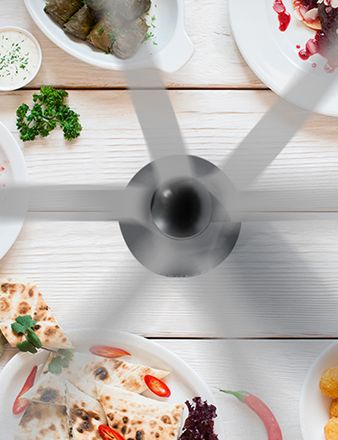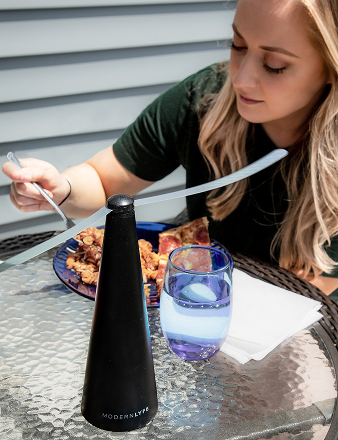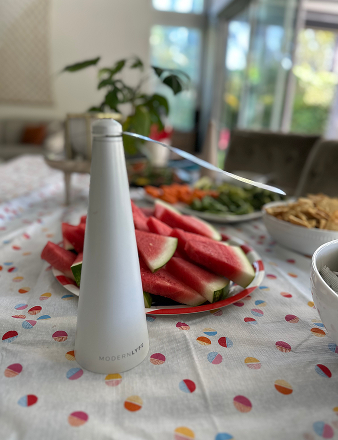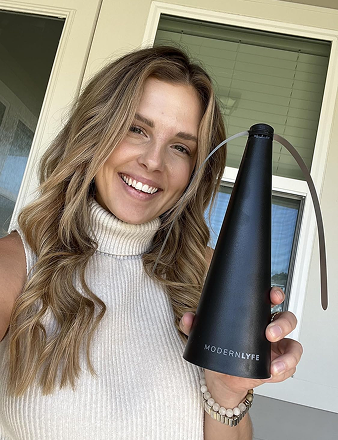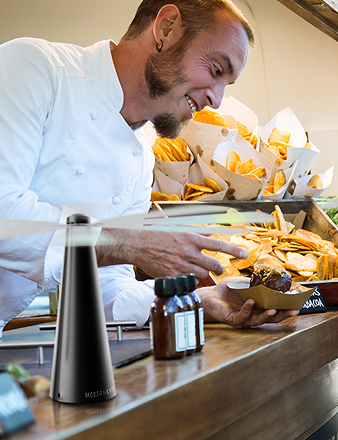Nothing ruins an outdoor meal faster than a swarm of flies. It’s a universal problem. If you want to reclaim your patio, you need more than a fly swatter; you need a smart, multi-layered strategy. Combine aggressive cleanup with natural repellents and modern tech. For a quick fix that works, a good fly fan can create an instant no-fly zone right over your table.
Your Guide to a Fly-Free Outdoors
An afternoon barbecue or a quiet evening on the deck can be ruined by constant buzzing. Flies aren't just annoying—they carry bacteria and are the last thing you want on your food. Constantly swatting them away is exhausting and ineffective. The real secret is to prevent them from showing up in the first place.
This guide provides practical, real-world advice to build a defense system against flies. It's about understanding what draws them to your yard so you can turn it from a fly magnet into a peaceful retreat. Let's make your outdoor space enjoyable again. It starts with a few key changes.
The Biggest Fly Magnets in Your Yard
To win the war against flies, you have to think like one. What are they looking for? Mostly, they're driven by a powerful sense of smell, constantly hunting for their next meal or a place to lay eggs. You’d be surprised how simple their top three temptations are to manage once you know what to look for.
The core of any fly control plan is removing their reasons for being there. Get rid of the food, water, and breeding spots, and the flies will go elsewhere. It’s that simple.
Take a look at what's really bringing them into your yard.
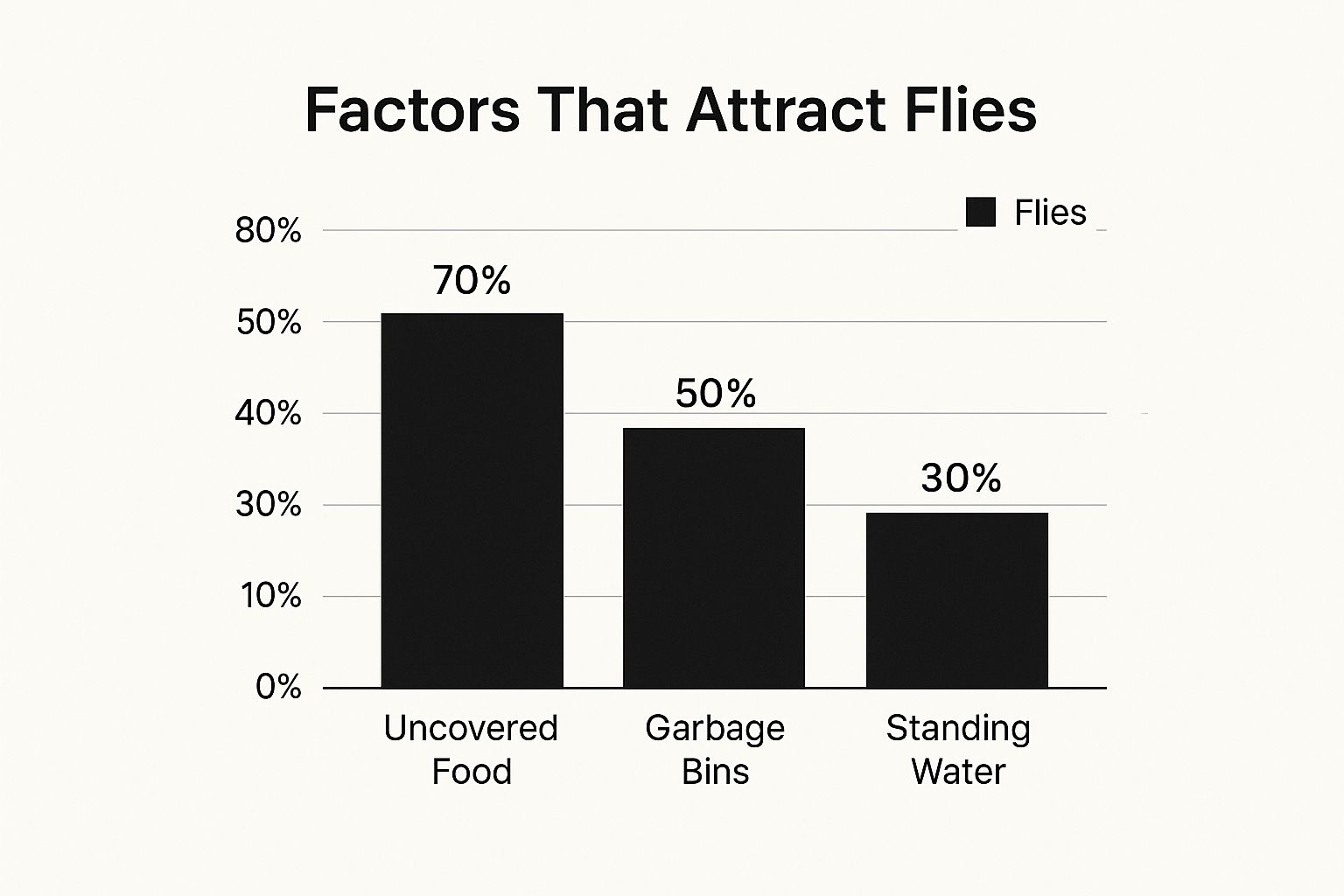
The numbers don't lie. Uncovered food is the #1 attractant, which is why outdoor dining can feel like ringing a dinner bell for every fly in the neighborhood. By tackling these three areas, you can make a massive dent in the fly population around your home.
Know Your Enemy: What Attracts Flies?
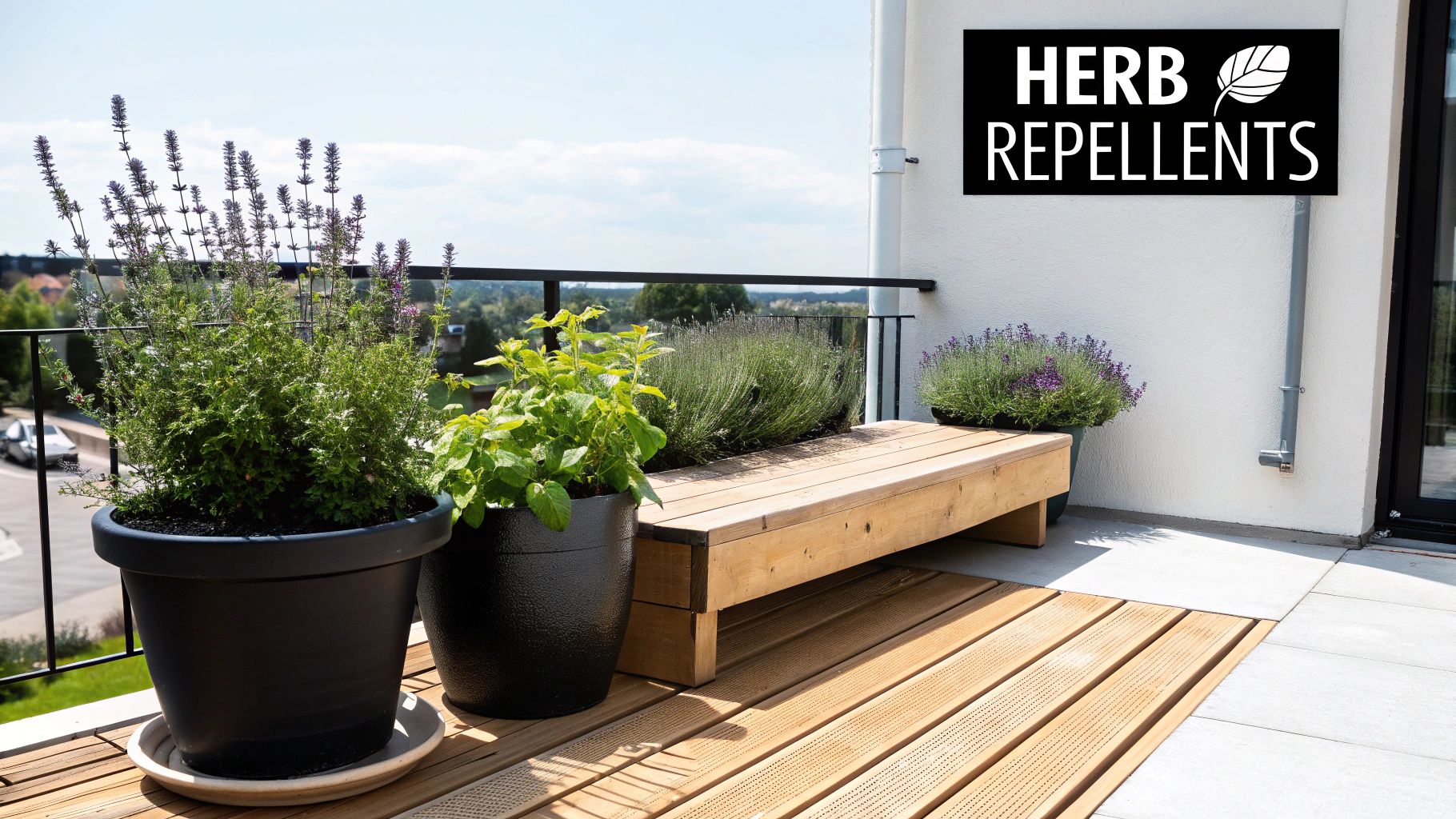
To win the war against flies, you must understand what drives them. It's simple. A fly’s world is governed by primal instincts: finding a meal, sourcing water, and locating a safe spot to lay eggs.
To a fly, your barbecue is an all-you-can-eat buffet. They have a phenomenal sense of smell that can detect organic scents from far away. A single burger on the grill or a full garbage can acts as a beacon, summoning every fly in the area. They aren't buzzing aimlessly—they're following a scent highway straight to your party.
The Key Environmental Triggers
Think of your backyard as a fly's potential paradise. Certain elements make it far more inviting. Knowing what they are is the first step to turning your space into a no-fly zone.
The biggest culprits are straightforward:
- Odors: This is number one. We're talking about leftover food, pet waste, fallen fruit, and open compost bins. All send a powerful invitation.
- Moisture: Flies need water to survive and breed. Puddles, leaky hoses, damp mulch, and overwatered planters create perfect breeding grounds.
- Heat: Flies land on warm surfaces like sun-drenched patios or dark cushions to conserve energy for their next food hunt.
Once you see your yard through a fly’s eyes, you can switch from swatting them away to preventing them from showing up. The goal is to make your space one they’ll instinctively pass over.
Getting Ahead of Seasonal Swarms
Fly populations aren't constant; they explode when conditions are right. Heat and humidity are the main drivers, speeding up their life cycle from egg to adult in as little as seven days. This is why you see a huge jump in their numbers after a warm, rainy period.
This isn't just an observation; scientists have tracked these patterns. A global study on the Mediterranean fruit fly found that its population spikes are directly tied to temperature and rainfall. You can learn more about these seasonal fly population dynamics at PMC NCBI. Knowing this helps you anticipate when flies will be at their worst so you can get your defenses ready ahead of time.
Build Your First Line of Defense with Sanitation
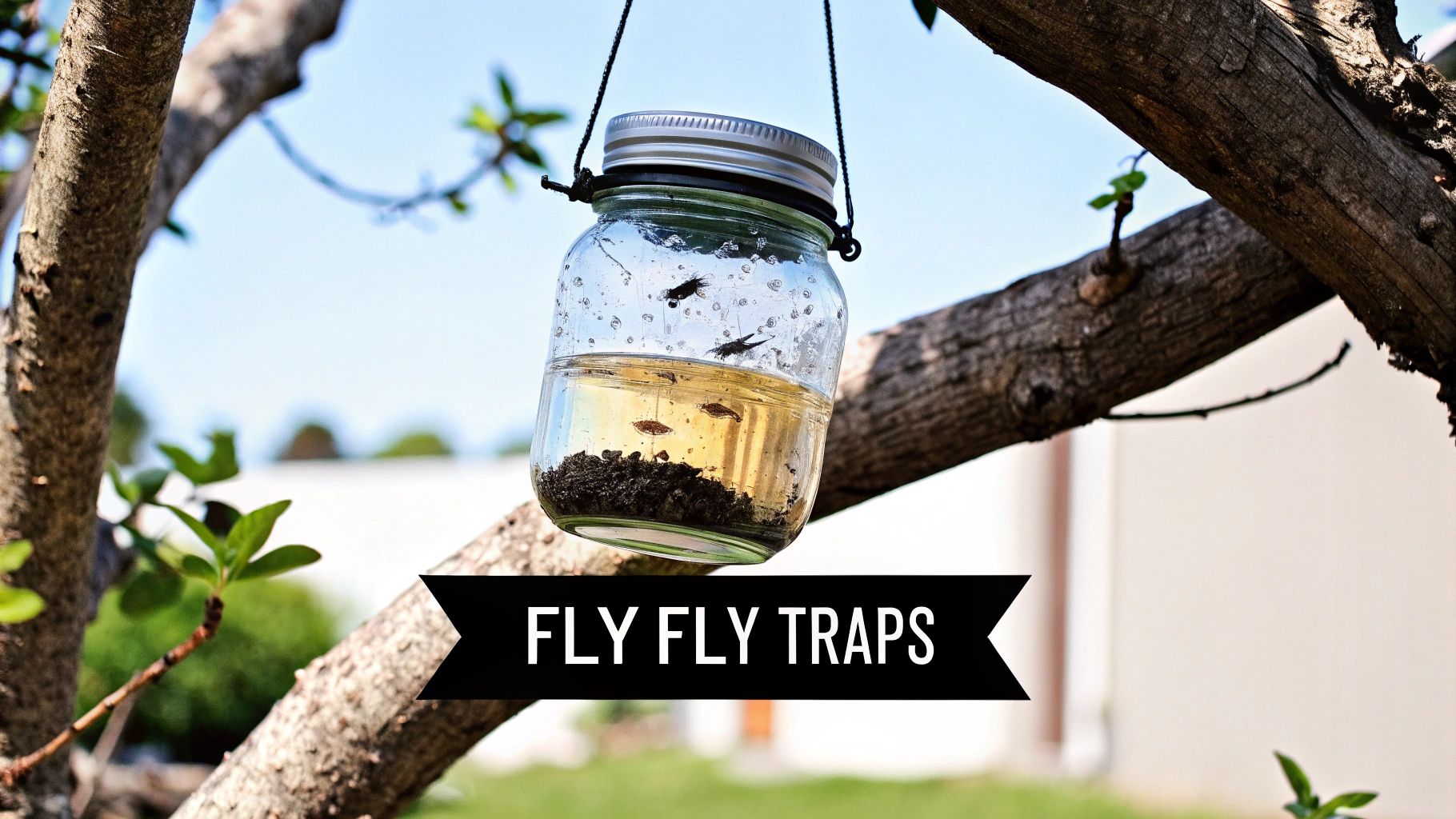
While fly fans offer immediate relief, the single most effective long-term strategy is making your space unappealing to flies. It’s all about going on the offensive and eliminating what attracts them. You have to cut off their supply lines.
Think of it this way: a clean outdoor area is your foundation. Flies are on a constant mission to scout for food and egg-laying sites. Even a small mess looks like a buffet to them. Take away their reason for showing up, and their numbers will plummet.
Going Beyond Basic Tidiness
Good sanitation isn’t just wiping up a spilled drink. It’s a new mindset: actively hunting down and managing anything that could attract flies. This proactive approach is what transforms a yard from a fly magnet into a no-fly zone.
Here’s where to focus your efforts:
- Trash Management: Your garbage can is ground zero. Always use bins with tightly sealing lids. Rinsing cans and bottles before tossing them makes a huge difference. In summer heat, take the trash out more frequently.
- Pet Waste Patrol: This is critical. Pet waste is not just an attractant; it’s a five-star fly nursery. Scoop it daily. If you don't, you're inviting them to move in and start a family.
- Grill and Food Cleanup: Leftover grease on your grill sends out an open invitation. Clean it thoroughly after every barbecue. For more tips, see our guide on how to keep flies away from food.
The goal is simple: turn your property into a "food desert" for flies. When there’s nothing for them to eat or breed in, they have no reason to stay. This makes every other fly-control method you use infinitely more effective.
Managing Potential Breeding Grounds
Any organic waste is a prime location for flies to lay eggs. This happens on a huge scale in agriculture, where a single large facility can produce over 4,000 metric tons of manure a year, creating a fly paradise. The principle is the same in your backyard, just on a much smaller scale.
Research from OUP Academic on fly development confirms that managing organic waste is proven to disrupt the fly life cycle.
Keep your compost pile covered and turn it regularly. Check for clogged gutters or spots with poor drainage—that mix of stagnant water and decaying leaves is the perfect breeding ground for the next generation of pests.
Use Natural Repellents and Strategic Landscaping

Beyond keeping things clean, you can make your outdoor space actively unpleasant for flies by working with nature. Strategic landscaping is a fantastic—and beautiful—way to deter flies without chemicals. The secret is using common herbs and flowers that release scents we love but flies can't stand.
This isn’t about chasing flies away after they arrive. It’s about creating an environment they’ll avoid in the first place. You're building a natural, 24/7 barrier that also happens to make your patio look and smell wonderful.
Placing Plants for Maximum Impact
Where you put these plants is just as important as what you plant. The goal is to position them in the areas you use most, creating overlapping zones of fragrance that flies have to cross.
- Potted Herbs on the Patio: This is a top-tier trick. Put pots of basil, mint, and rosemary on dining tables or along the edge of your deck. Their potent aromas create an immediate "no-fly zone."
- Window Boxes: Placing these same herbs in window boxes by your back door or kitchen window can stop flies from coming inside every time the door opens.
- Garden Bed Borders: Planting lavender and marigolds along the edges of garden beds that border your seating areas is a game-changer. The breeze carries their scent, adding another layer of protection.
When you weave these plants into your landscape, you aren't just decorating—you're building a living, functional barrier. It’s a low-effort way to make your main outdoor spaces less appealing to pests.
The magic is in the essential oils found in plants like basil and mint. Basil leaves contain natural compounds that flies find offensive. This makes it a perfect two-for-one plant: you get fresh herbs for your summer salads and a fly-free spot to enjoy them. This kind of multi-purpose thinking makes natural landscaping a smart and sustainable way to reclaim your backyard.
When you need to clear flies right now, long-term strategies like sanitation and landscaping won't cut it. For immediate, on-the-spot relief at your dinner table or outdoor bar, technology is your best friend. This is where fly fans come in—a brilliantly simple way to create an instant, pest-free bubble of peace.
The concept is surprisingly straightforward. The soft, rotating blades create a gentle, consistent breeze. It's barely noticeable to us, but for a fly, it's like trying to land a helicopter in a hurricane. They simply can't navigate the air current to get to your food. It’s an invisible, silent barrier.
The Science of Disruption
But it's not just about the breeze. The most effective fly fans, like the ones we've tested, add another layer of defense: visual confusion. The blades on these fans almost always feature a reflective, holographic pattern.
A fly has compound eyes that are incredibly sensitive to shifting light and movement. The spinning, reflective patterns on the fan blades completely overwhelm their visual sensors. It creates a disorienting, chaotic environment that they instinctively want to escape.
This two-pronged attack—disrupting their flight with air and their sight with light—is what makes these gadgets so effective. You're hitting two of a fly's most critical senses at once, creating a zone they actively avoid. Best of all, it's non-toxic, quiet, and works instantly.
Getting the placement right is crucial for maximum effect. One fan is usually perfect for a small, four-person table. But for bigger tables or long buffet lines, you’ll need a couple to do the job right.
- For a standard 6-8 person rectangular table: Place one fan at each end. This creates an overlapping air current that protects the entire surface.
- For a large round table: Placing two fans on opposite sides gives you complete, gap-free coverage.
By setting them up strategically, you're essentially building an invisible shield over your food and drinks, keeping your meal peaceful and your guests happy. You can check out our guide on the best fly repellent fan to see which models and setups we recommend. It's a simple addition that can transform your entire outdoor dining experience.
Your Outdoor Fly Control Questions, Answered
Even with the best game plan, questions pop up. Let’s tackle the most common questions about keeping flies away outside so you can fine-tune your approach and finally get some peace.
What’s the single best way to keep flies away outside?
There isn't one magic trick. The most effective strategy is a layered one.
Think of it as a one-two punch. First, be relentless about sanitation—no food scraps, sealed trash cans, and cleaning up spills immediately. That's your foundation.
Then, for immediate relief where you're eating, fly fans are your best friend. They create a fly-free bubble around your table. We have a great guide on how to banish buzzing pests with a Modern Lyfe fly fan that walks you through it. Pair that with long-term natural deterrents like mint and rosemary planted nearby, and you've built a solid defense.
Why are there suddenly so many flies in my yard?
If you're suddenly dealing with a fly invasion, it's almost always because a new breeding ground has appeared nearby. It's time to play detective.
Look for the obvious culprits first: a forgotten garbage bag, pet waste that wasn't picked up, or a compost pile that’s too active. A recent spike in heat and humidity can also kick their life cycle into overdrive, leading to what feels like an overnight population explosion.
Pro insight: pest control experts often use counting grids to gauge the severity of a problem. Seeing fewer than five flies is typical. If you're spotting over 20 flies in a small area, that’s a clear sign of an infestation that needs serious attention. You can read more about these professional fly monitoring techniques on The Poultry Site.
What scent do flies absolutely hate?
Flies can't stand strong, sharp botanical scents. Their sensitive sense of smell gets overwhelmed by them.
The biggest offenders for them are:
- Peppermint
- Lavender
- Basil
- Eucalyptus
Use essential oils from these plants in a diffuser on your patio table, or even better, plant them directly in pots or garden beds around your seating areas. This creates a natural, great-smelling repellent barrier that works 24/7 without any effort.
Ready to reclaim your outdoor dining? The MODERN LYFE fly fan offers a quiet, effective, and stylish solution to keep your food and guests protected. Visit modernlyfe.com to create your fly-free zone today.

